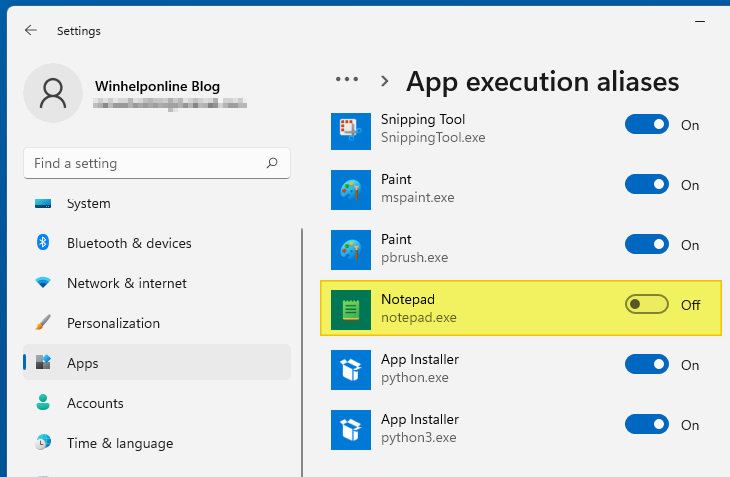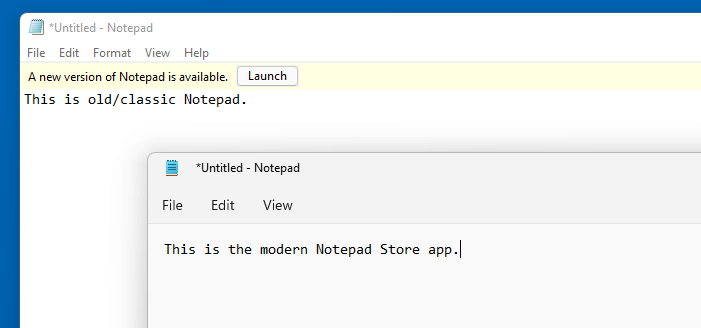Credit: https://www.winhelponline.com/blog/restore-old-classic-notepad-windows/
Windows 11 comes with the modern Notepad app that automatically replaces the old/classic Notepad program. The new Notepad UWP app supports color emojis, dark mode, RichEdit editing enhancements, Ctrl+} for toggling between matching brackets/parentheses, multilevel undo, drag & drop, and automatic URL detection.

However, many users prefer classic/win32 apps instead of modern Store apps. The classic Notepad is exceptionally lightweight and has always been my favorite.
Drawbacks of installing the modern Notepad app: The modern Notepad app in Windows 11 hides classic Notepad’s entry points (e.g., Open with menu/dialog and Default Apps) so that users can’t launch the classic version. Attempting to run c:\windows\notepad.exe would redirect you to the Notepad store app instead. This redirection is due to the “AppExecutionAliasRedirect” registry setting. Also, replacing Notepad with Notepad++ using the IFEO “debugger” registry value would stop working (by default) if modern Notepad is installed on the computer.
This article tells you how to get back the old Notepad after installing or uninstalling the modern Store app in Windows 10/11.
How to Restore the Old/Classic Notepad in Windows 11
Follow one of these methods to restore the classic Notepad program in Windows 11/10:
(You should be able to run the modern Notepad and traditional Notepad programs simultaneously/side by side after following the methods below.)
Method 1: Disable the Notepad App execution alias
The modern Notepad overrides the old Notepad via the “App Paths” registry key so that the new Notepad launches when launching Notepad.exe. By disabling this alias via the Settings app, you should be able to run the classic Notepad.
- Open Settings → Apps.
- Expand “More settings” and click “App execution aliases.”
- Disable the “Notepad” alias by turning off the radio button.

That’s it! When you double-click on a text file or run Notepad.exe manually, the classic Notepad will now open. You can still launch the new Notepad via the Start menu or Taskbar shortcut, or by launching the executable file directly.
Example:
C:\Program Files\WindowsApps\Microsoft.WindowsNotepad_11.2203.10.0_x64__8wekyb3d8bbwe\Notepad\Notepad.exe
Note: However, this method doesn’t restore the classic Notepad in the Open with dialog. Also, it can’t fix the “Cannot associate file type with this program” error discussed in the next paragraph.
Disabling the Notepad alias (as above) or uninstalling the modern
Notepad app via Settings → Apps & Features would enable you to launch
the classic Notepad successfully. However, the classic Notepad would
still be missing in the Open with dialog and Open with menu due to
specific registry settings. Attempting to browse and select
notepad.exe in the Open with dialog would cause the following error:
Cannot associate file type with this program
The program you have selected cannot be associated with this file type. Please choose another program.
You’ll need to follow “Method 2” ↓ to fix this issue.
Method 2: Restore Classic Notepad via the registry
This method restores the classic Notepad and also makes it available in the Open with dialog/menu.
(Note: Additionally, this method should enable you to replace Notepad with Notepad++ or any other editor if required.)
Copy the following lines to Notepad.
Windows Registry Editor Version 5.00 ;Restore Old Classic Notepad on Windows 11 ;Created by Ramesh Srinivasan for Winhelponline.com ;Created on May 6, 2022; Revised on May 12, 2022. [HKEY_CLASSES_ROOT\Applications\notepad.exe] "NoOpenWith"=- [-HKEY_CURRENT_USER\Software\Microsoft\Windows\CurrentVersion\App Paths\notepad.exe] [HKEY_CLASSES_ROOT\txtfilelegacy\DefaultIcon] @="imageres.dll,-102" [HKEY_CLASSES_ROOT\txtfilelegacy\shell\open\command] @="C:\\Windows\\System32\\notepad.exe \"%1\"" [HKEY_LOCAL_MACHINE\SOFTWARE\Microsoft\Windows NT\CurrentVersion\Image File Execution Options\notepad.exe] "UseFilter"=dword:00000000- Save the file with a .reg extension — e.g., restore_classic_notepad.reg
- Close Notepad.
- Double-click restore_classic_notepad.reg to apply the settings to the registry.
You’ve now restored the functionality of the old classic Notepad program!
Download: If you wish to download the registry file (instead of making one of your own), download restore-classic-notepad.zip, unzip and run the appropriate registry file. It also has the undo.reg file which reverses the above registry settings to Windows default.
Here you go! The Open with dialog will now list both versions of Notepad, easily distinguishable from the respective icons.
RELATED: How to Get Windows 10 Classic Paint in Windows 11
Here’s the comparison of the old and new Notepad UI. The old Notepad shows a notification bar that says, “A new version of Notepad is available”. However, once you close the banner, it shouldn’t prompt you the next time onwards.

After restoring the old Notepad, you may run it alongside the modern Notepad app. Or you may uninstall the modern Notepad app if you don’t plan to use it.
Closing words!
The registry method in this article has been tested on Windows 11 Version 21H2 OS Build 22000.613. In the future, if Microsoft eradicates the old Notepad binaries, we should be resorting to other methods (copying Notepad.exe and Notepad.exe.mui from earlier builds of Windows 10/11) to restore the classic Notepad.





0 comment